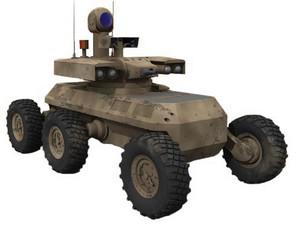Killer robotsKiller robots already exist, and they’ve been here a very long time
The question is not so much whether we should use autonomous weapon systems in battle – we already use them, and they take many forms. Rather, we should focus on how we use them, why we use them, and what form – if any – human intervention should take.

Killer bots are not a recent development // Source: wikipedia.org
Humans will always make the final decision on whether armed robots can shoot, according to a statement by the U.S. Department of Defense. Their clarification comes amid fears about a new advanced targeting system, known as ATLAS, that will use artificial intelligence in combat vehicles to target and execute threats. While the public may feel uneasy about so-called “killer robots”, the concept is nothing new – machine-gun wielding “SWORDS” robots were deployed in Iraq as early as 2007.
Our relationship with military robots goes back even further than that. This is because when people say “robot”, they can mean any technology with some form of “autonomous” element that allows it to perform a task without the need for direct human intervention.
These technologies have existed for a very long time. During World War II, the proximity fuse was developed to explode artillery shells at a predetermined distance from their target. This made the shells far more effective than they would otherwise have been by augmenting human decision making and, in some cases, taking the human out of the loop completely.
So the question is not so much whether we should use autonomous weapon systems in battle – we already use them, and they take many forms. Rather, we should focus on how we use them, why we use them, and what form – if any – human intervention should take.
The birth of cybernetics
My research explores the philosophy of human-machine relations, with a particular focus on military ethics, and the way we distinguish between humans and machines. During World War II, mathematician Norbert Wiener laid the groundwork of cybernetics – the study of the interface between humans, animals and machines – in his work on the control of anti-aircraft fire. By studying the deviations between an aircraft’s predicted motion, and its actual motion, Wiener and his colleague Julian Bigelow came up with the concept of the “feedback loop”, where deviations could be fed back into the system in order to correct further predictions.
